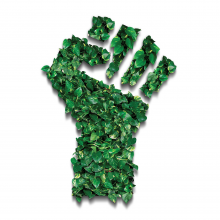change climate
DURING THE COP 28 climate change conference in Dubai, participants deliberated at length on the climate crisis and rightly set ambitious goals to address the challenges. As may seem natural, much of the conversation centered on securing a planet habitable for humans. But as Christians we must wrestle deeply with sharing God’s covenant with other creatures. Seeing creatures and the natural world as having no meaning other than how they serve human interest is a failure of human vision. The 2007 documentary Earth poignantly highlighted how an anthropocentric worldview and the human-caused environmental crisis have imperiled other creatures in a miraculously delicate system.
Perhaps out of species self-interest, much environmental work focuses on how climate shifts impact current and future human generations. But as people of faith, we can take a more wholistic view that also demonstrates commitment to the well-being of all God’s creation — animate and inanimate — because all are interdependent. In the context of the climate crisis, corrective justice requires addressing the concerns of communities disproportionately affected by climate collapse, as well as ensuring the welfare of nonhuman creatures. It is incumbent upon us to challenge the anthropocentric lens and champion biocentric approaches that affirm the sanctity of all life and creation. Our scripture readings this month present nonhuman creatures as equal partners on God’s planet and speak forcefully about their right to exist and thrive alongside our human communities. They feature animals dancing in open spaces, frolicking in the sea, and celebrating life in its fullness. Everything in nature reflects God’s glory, participates in God’s salvation, and reminds us of the divine presence.
SINCE LAST SEPTEMBER, when Swedish schoolgirl Greta Thunberg began her one-woman campaign, school strikes have happened around the planet. At their height in the spring, 1.4 million kids left class for a day, demanding that our leaders actually lead on the greatest crisis the planet has ever faced. In May, the students asked adults to join them, and so on Sept. 20 the first all-ages climate strike will take place across the planet.
Here’s why you should join in making it the largest day of climate protest in human history:
1) Because the climate crisis just keeps deepening.
When I wrote the first book about all this, 30 years ago this fall, scientists were issuing warnings about what would happen if we didn’t act.
During his second inaugural address, President Obama reframed protecting the environment as a command from God. Slate reports this reframing “transcends not only partisanship but the divide between those who believe in science and those who doubt science but believe in God.” Obama said:
"The path towards sustainable energy sources will be long and sometimes difficult. But America cannot resist this transition; we must lead it. We cannot cede to other nations the technology that will power new jobs and new industries — we must claim its promise. That is how we will maintain our economic vitality and our national treasure — our forests and waterways; our croplands and snowcapped peaks. That is how we will preserve our planet, commanded to our care by God. That's what will lend meaning to the creed our fathers once declared."
Mother Jones reports:
"Cap and trade" may be a dirty expression inside the DC Beltway, but as of today in California it's the law of the land. Gov. Jerry Brown has brushed aside dire warnings from the fossil fuel industry to forge ahead with the state's first-ever auction of emissions permits under its groundbreaking climate law, AB 32. This morning's auction marks the official launch of the world's second-largest carbon market.
At heart, the concept is elegantly simple. Suppose you wanted to persuade a group of 10 pack-a-day smokers to cut back, and you controlled the cigarette supply. In the beginning, you'd provide the group with 200 cigarettes (10 packs) a day, which they'd have to bid for. That's the "cap." Then, each month, you would reduce each person's daily allottment of smokes, gradually lowering the cap. The people who managed to smoke less could sell their extras to the more hard-core smokers for whatever they were willing to pay. That's the "trade" part.
Read more here.
[Editor's Note: On October 10 (10.10.10), 350.org is coordinating 2700 events in 150 countries to address the concerns of climate change together as a planet.

